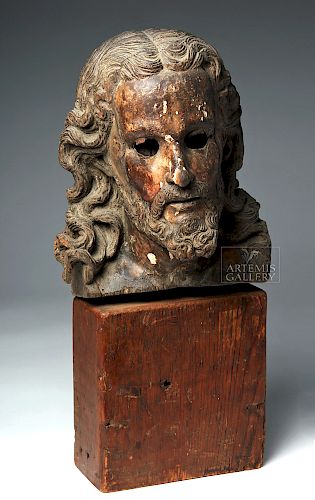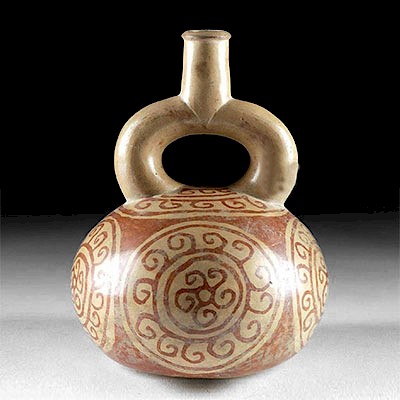Rare 18th C. Life-Size Wooden Head of Jesus - Ecuador
Lot 153A
About Seller
Artemis Gallery
686 S Taylor Ave, Ste 106
Louisville, CO 80027
United States
Selling antiquities, ancient and ethnographic art online since 1993, Artemis Gallery specializes in Classical Antiquities (Egyptian, Greek, Roman, Near Eastern), Asian, Pre-Columbian, African / Tribal / Oceanographic art. Our extensive inventory includes pottery, stone, metal, wood, glass and textil...Read more
Estimate:
$5,000 - $7,500
Absentee vs Live bid
Two ways to bid:
- Leave a max absentee bid and the platform will bid on your behalf up to your maximum bid during the live auction.
- Bid live during the auction and your bids will be submitted real-time to the auctioneer.
Bid Increments
| Price | Bid Increment |
|---|---|
| $0 | $25 |
| $300 | $50 |
| $1,000 | $100 |
| $2,000 | $250 |
| $5,000 | $500 |
| $10,000 | $1,000 |
| $20,000 | $2,500 |
| $50,000 | $5,000 |
| $100,000 | $10,000 |
| $200,000 | $20,000 |
About Auction
By Artemis Gallery
Jan 24, 2019
Set Reminder
2019-01-24 10:00:00
2019-01-24 10:00:00
America/New_York
Bidsquare
Bidsquare : Pre-Columbian / Ethnographic Art
https://www.bidsquare.com/auctions/artemis-gallery/pre-columbian-ethnographic-art-3814
Featuring ancient and ethnographic art from around the world, including Pre-Columbian, Native American, African / Tribal, Ethnographic, Spanish Colonial, Fossils, Fine Art, much more. Artemis Gallery info@artemisgallery.com
Featuring ancient and ethnographic art from around the world, including Pre-Columbian, Native American, African / Tribal, Ethnographic, Spanish Colonial, Fossils, Fine Art, much more. Artemis Gallery info@artemisgallery.com
- Lot Description
Spanish Colonial, Ecuador, ca. 18th century CE. A finely carved wooden head of Jesus, life size and used by artisans as a model for creating grand Cristo figures. Note the remarkable detail of His facial contours covered with a thin layer of gesso as well as the skillfully delineated cascading long hair with meticulously incised locks, curly mustache and beard. Though a creation of the New World, the Cristo recalls the realism that emerged in 17th century Spanish religious sculptures and paintings. Such realism was purposefully sought in order to combat Protestantism and revitalize the Catholic Church. Artists aimed to create vivid and naturalistic imagery that was at the same time dramatically emotive, and soulful. This Christ figure far surpasses any naive, folk approach and was very much influenced by academic study of anatomy and the dramatic Spanish Baroque style championed by masters such as sculptor Juan Alonso Villabrille y Ron and painters Diego Velazquez and Francisco de Zurburan. Size: 8.375" L x 10" W x 11.625" H (21.3 cm x 25.4 cm x 29.5 cm); 20.375" H (51.8 cm) on included custom stand.
During the 17th century, Spanish art existed in isolation from the rest of the world. However, in the 18th century with the accession of the Bourbon dynasty, many foreign artists came to Madrid to decorate the new royal palaces, and Madrid became a center for Baroque art. Spain grew less and less isolated; their interactions with other cultures resulted in the introduction of other artistic practices and traditions. Given that there were an increasing number of commissions from monumental churches, elite households, and royal families, the demand for fine decorative art increased as well. Church altarpieces in particular were elaborately decorated with sculptures, columns, and reliefs, to create what the Germans referred to as Gesamtkunstwerk - a total work of art. This Spanish Colonial piece was influenced by the Spanish Baroque tradition of church decoration, spreading this visual culture practice to the New World.
Provenance: private Andrade collection New York, NY, USA acquired 1960's; ex-Knoedler & Company
All items legal to buy/sell under U.S. Statute covering cultural patrimony Code 2600, CHAPTER 14, and are guaranteed to be as described or your money back.
A Certificate of Authenticity will accompany all winning bids.
We ship worldwide and handle all shipping in-house for your convenience.
#131245Glass eye inlays missing. Expected surface wear with scuffs and nicks to gesso and wood as shown. Old losses to peripheries and nicks to surface of the base. Age cracks as shown, but the line of separation between the face and the rest of the head/coiffure indicate that the face was carved separately. Inactive insect damage particularly to the verso. Old nails indicate that the lower back perimeter of the figure's hair was reattached.Condition
- Shipping Info
-
All shipping is handled in-house for your convenience. Your invoice from Artemis Gallery will include shipping calculation instructions. If in doubt, please inquire BEFORE bidding for estimated shipping costs for individual items.
-
- Buyer's Premium



 EUR
EUR CAD
CAD AUD
AUD GBP
GBP MXN
MXN HKD
HKD CNY
CNY MYR
MYR SEK
SEK SGD
SGD CHF
CHF THB
THB















